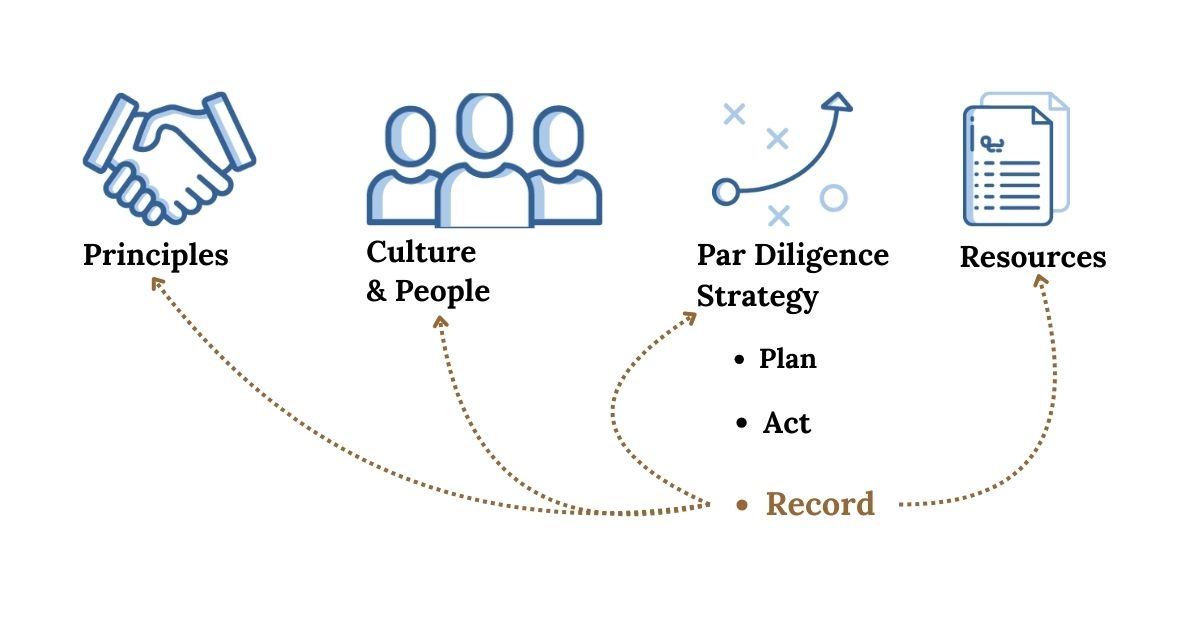Feb 8, 2025
The Meaning of Recording Under the Diligence File Framework
PAR Diligence StrategyRecord

How does record apply to your diligence project? Today’s post lists questions, issues and categories to consider when assessing what and when to record.
The Diligence File Framework
Under the Diligence File Framework, an organization that values and understands the power of diligence:
- Formulates, communicates and follows Principles
- Empowers, respects and rewards a Culture of diligence and diligent People
- Delivers guidance and strategies such as the PAR Diligence Strategy
- Provides the Resources needed to perform and sustain great diligence
The Diligence File Framework is designed to be practical with the PAR Diligence Strategy – PLAN – ACT – RECORD – using a series of action steps that lead you to your diligence goals. Record is a part of the PAR diligence strategy, but it does apply to every action you take under the Diligence File Framework.
Think of it this way:

And although record applies to the entire framework, this post focuses on how record applies to a specific diligence project so that you can develop your own definitions, processes and procedures that you use around the concept of “record”. To help I am listing questions, issues and categories that I consider when I assess what and when to record.
As you review this post I encourage you to develop your own criteria and define rules for what and when to record. Your circumstances, organization, industry and laws will be part of the development of your own custom “record” rules.

What Does it Mean to Record your Diligence?
Record means the actions that you take to Collect, Preserve and Retrieve materials that are relevant to your diligence project.
- Collect – means how you gather materials or information from materials into your control. For example do you take notes, make screenshots, download pages of a site, record an interview, keep the hard copy of a textbook.
- Preserve – means how do you save the materials so that they retain their integrity. Integrity refers to saving material so that it can not be altered and protecting against loss, deterioration and destruction.
- Retrieve – means how do store the materials so that you can locate them and have access to them within a reasonable time frame.

How are materials defined?
Materials is any content, in any form that you use or generate during a diligence project. It can be digital or hard copy and it may be written, visual or auditory.
I find it useful to divide materials into three types of content:
Researched – content you find on as a result of your research. This may include websites, social media posts, books, reports, government documents, documentary films, photographs, recordings, interviews.
Generated – content that you, a team member, an expert, even a system generate in response to, as a reaction to or as result of information found during research. Some examples of this may include, notes, reviews, impressions, conclusions, data aggregation, data mining or processing, charts, spreadsheets, infographics or drawings.
Adjacent – content that is connected to your other content or your diligence project. This may include any guidance you received about the project, team chats, texts, emails, project instructions, meeting notes, policies, copies of applicable regulations, forms, sign offs and even confirmations of submissions through platforms or applications.
These are my definitions you can also use if you find it helpful for your work.

How is relevant defined ?
Relevancy depends on your circumstances. I find that the types of criteria that define relevancy include:
– Is there a legal, regulatory, compliance, industry or internal requirement that defines or lists material that must be collected, preserved and retrieved?
– Did the material significantly contribute to, my understanding, analysis or reasoning of any element of the project?
– Does the material provide context around the diligence project?
– Will I need the material again and if so, will I be able to find it again in the identical format?
Sometimes I don’t know if materials are relevant until the end of the project. I usually “over collect” and at the end of the project I do a review. If something I saved isn’t relevant I discard it and if I am missed something I go back and capture it.

What systems or technologies are used to record?
Again, this depends on your situation.
- Do you have legal/regulatory/industry requirements that define how you record? For example, the financial services and healthcare industries are highly regulated and have multiple requirements that impact the choice and use of recording systems and technology.
- What are your resources? How much time, money, assistance and expertise are available to you?
- What are your internal requirements? Is paper allowed, is everything digital?
- If you are working solo and there are no external requirements, what works best for you?
There are organizations with sophisticated, global, interconnected knowledge management, content creation platforms, and communication systems and there are organizations that generate hard copies and put them in a file cabinet. And of course there is an entire spectrum of possibilities between these two examples.
What is essential is an understanding of what is expected based on your legal requirements, industry, organization and your team so that you can make sure that when your record you meet those expectations.

Here are some other things to consider!
- Know your legal requirements. Even unregulated businesses may have recording obligations under general business and tax laws.
- Always consult your internal recording/retention/archive policies and procedures and if you need clarification ask for assistance at the start of the project.
- Everyone on a team or a project should have the same definition and understanding of “Record”
- If possible materials should be digital, even if they start out as paper they can be scanned and tagged.
- Your need to record may be ongoing so build this into your project.
- Records and the process of recording need to comply with privacy and security requirements.
- There are many resources and applications available around capturing, retaining and preserving materials so do your diligence around what works for your circumstance.

Sign Up to Receive the Diligence File Emails – More Ideas & Resources to Advance Your Diligence
Thank you


Subscribe for Diligence Updates
Get the latest updates, resources, offers, and more.
"*" indicates required fields
The Diligence File respects your privacy. Privacy Policy